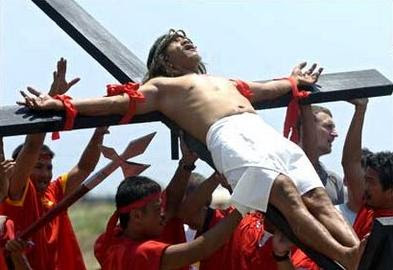 Devotees re-enacted Jesus's crucifixion in gory scenes while millions of other less extreme faithful across the Catholic Philippines prayed with their families on Good Friday.
Devotees re-enacted Jesus's crucifixion in gory scenes while millions of other less extreme faithful across the Catholic Philippines prayed with their families on Good Friday.A handful of people are traditionally nailed to crosses while hundreds more have their backs whipped until they bleed in Asia's major Catholic outpost, to remember the day when Christians believe Jesus Christ died 2,000 years ago.
In the small farming town of Cutud, a couple of hours' drive north of Manila, thousands of tourists gathered to watch what has over the years become the biggest and bloodiest Good Friday spectacle.
Fourteen people were nailed to crosses and hundreds were whipped as they walked through the town, their blood splattering onto the ground and walls of buildings.
The most senior of those nailed to a cross, Ruben Enaje, 50, said he was going through the ordeal this year for the 25th time as a way of giving thanks to God for allowing him to survive an accident unscathed.
"I will do this for as long as I can endure it," Enaje told reporters.
Enaje, playing the part of Jesus, was led by villagers dressed as Roman centurions to a hill on the outskirts of town.
Nails were driven through Enaje's palms and he hung on the cross for 10 minutes while grimacing in pain, before being taken down so that the others could take their turns.
 The Catholic Church has discouraged the practice and criticised the organisers of the Cutud event for commercialising Good Friday in an effort to attract tourists, but the "penitentes" were unapologetic.
The Catholic Church has discouraged the practice and criticised the organisers of the Cutud event for commercialising Good Friday in an effort to attract tourists, but the "penitentes" were unapologetic."If they only respected our panata (sacred vows). This comes from the depths of our heart. We are not showing these off, we have our own beliefs," Enaje said before he was nailed to cross.
Enaje said he heard that other Philippine villages were paying people to be crucified, but insisted that things were different in Cutud.
"The people in Cutud are sincere. We aren't doing it for the money," he said.
But as the religious ceremonies went on in Cutud, dozens of vendors hawked souvenirs, hats, cold drinks and snacks to the crowds of curious locals and Western tourists.
German photojournalist Gunther Deichmann, a longtime resident of the Philippines, said the event was not as genuine as it had once been.
"It's a little bit more like a carnival now. Maybe 20 years ago it was more realistic," he said.
District tourism officer Ching Pangilinan denied church charges of commercilisation, saying local authorities had an obligation to manage the event to prevent tourists from mobbing the place or being robbed.
"People just come whether we promote it or not. So tourism assistance is necessary," she said.
One of the most outspoken critics of the bloody rituals, Catholic Archbishop Rolando Tirona of a Manila district, said they were a misreading of church teachings, but he conceded there were powerful cultural reasons behind them.
"The panata becomes so personal that nobody can correct or change them. They promise they will do this if their sick grandmother gets better and when she gets better, they say they have to fulfil their vows," Tirona told AFP.
Elsewhere in the country, Good Friday was marked with extreme solemnity with virtually all offices, shops and restaurants closed for the day.
Music, laughter and loud noises are all discouraged as a sign of respect.
Instead, Catholics made pilgrimages to different churches to pray, following the "stations of the Cross", or Christ's journey from the Last Supper to his crucifixion and resurrection.
Nearly 80 per cent of people in the Philippines are Catholic, a legacy of the nation's 300 years of Spanish colonial rule that ended at the turn of the 20th century.
Source: Herald Sun
Please post your comments.


1 comments:
Have seen this on TV. This practice is also common in south america.
Post a Comment
Please use a name or a pseudonym when posting a comment.